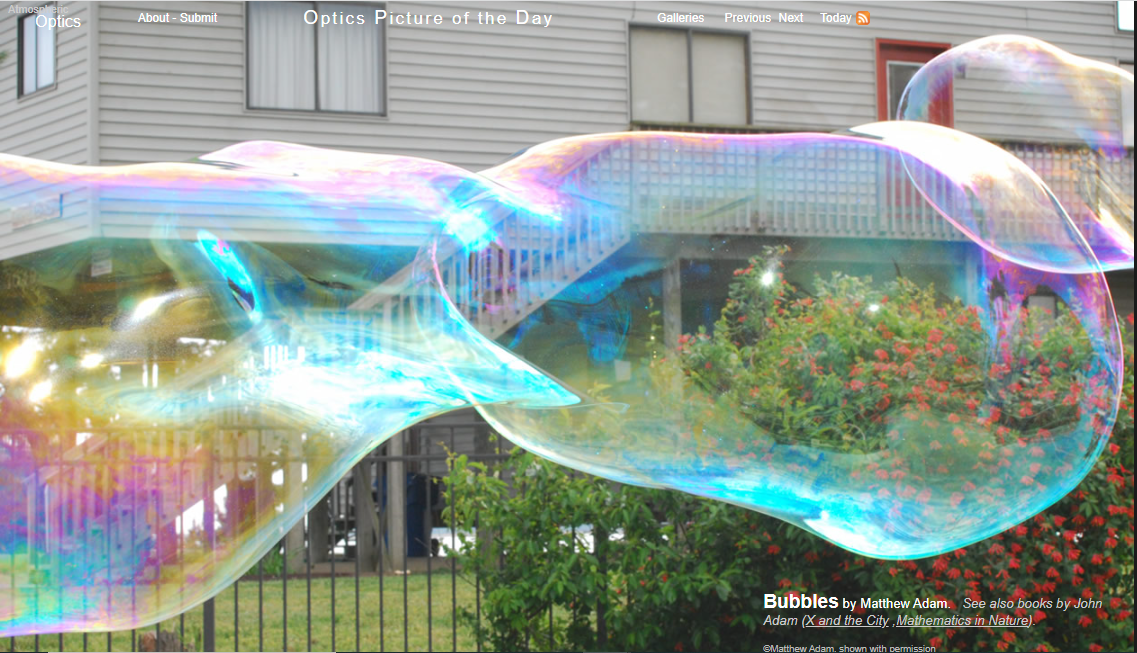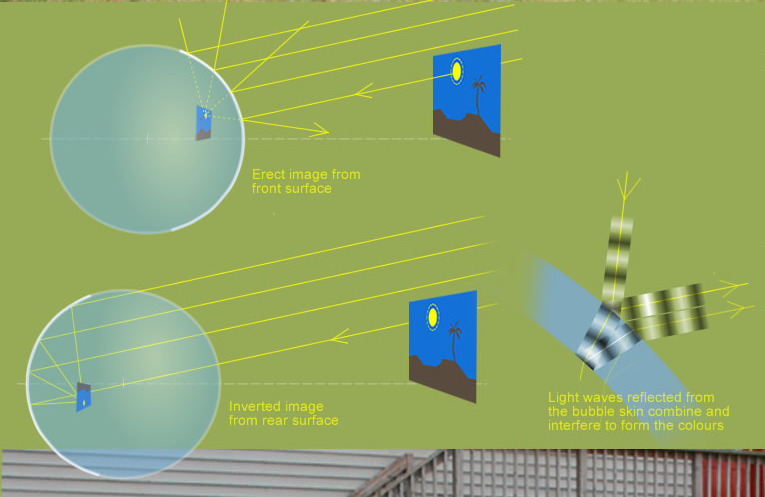OPOD - Bubbles!
OPOD - Bubbles: A Closer Look at the Fascinating Optical Phenomenon
Bubbles have captivated us since childhood, with their shimmering colors and delicate nature. While geometric optics can explain their reflections, it is the realm of wave optics that truly unveils the secrets behind their vibrant hues. These ephemeral spheres are a testament to the battle between surface tension forces, which strive to maintain their spherical shape. To understand the existence of bubbles, we must delve into the intricate world of molecular interactions and the forces that bind certain molecules together while repelling others.
Reflections: A Tale of Two Images
If you take a closer look at the reflections on a bubble's surface, you'll notice something intriguing. There are not one, but two images present. The upper image appears upright, while the lower one is inverted. The lower image provides a clearer view of the upright reflection. The reason behind this phenomenon lies in the bubble's structure. The front surface of the bubble acts as a convex mirror, creating the upright image. Conversely, the rear surface acts as a large concave mirror, producing the inverted image.
Iridescent Colors: Unveiling the Beauty of Thin-Film Interference
One of the most captivating aspects of bubbles is their iridescent and ever-changing colors. To understand this optical marvel, we must explore the concept of thin-film interference. Soap bubble films are incredibly thin, measuring only a few wavelengths of light across. As skylight reaches the outer surface of a bubble, some of it is directly reflected, while a portion enters the film. This incoming light then encounters the inner surface of the film, where it is partially reflected back in the same direction as the directly reflected waves.
The Dance of Interference
As these two sets of waves—directly reflected and internally reflected—overlap, they create a mesmerizing dance of interference. In certain directions and for specific colors, the wave crests align, resulting in a bright and vivid display. These are the colors we observe as we marvel at a bubble's iridescence. However, in other directions or for different colors, the two sets of waves may be out of phase and cancel each other out, leading to a lack of color or a dull appearance. Interestingly, the rear surface of the bubble independently contributes a second set of interference colors, further enhancing the complexity of the visual spectacle.
Exploring the Science Behind Bubble Formation
While we appreciate the aesthetic beauty of bubbles, understanding their formation requires us to delve into the underlying science. Bubbles are formed when a liquid, such as soap solution, traps air or another gas inside a thin film. Surface tension forces play a crucial role in maintaining the spherical shape of the bubble. These forces arise from the cohesive nature of liquid molecules, which tend to stick together. This cohesive force is responsible for minimizing the surface area of the bubble, resulting in its spherical form.
The Role of Molecule Interactions
To fully comprehend why bubbles exist at all, we must consider the intricate interactions between different molecules. Certain molecules exhibit a strong affinity for each other, causing them to stick together and form stable films. These molecules are known as surfactants and are crucial components of soap solutions. Surfactants have a unique structure that allows them to reduce the surface tension of water and create stable films when mixed with air or other gases. By reducing surface tension, surfactants enable the formation of bubbles and enhance their stability.
The Bubble's Lifespan
Bubbles are inherently delicate and ephemeral, with their lifespan dependent on various factors. The thin film that encases the trapped air or gas is susceptible to evaporation, causing the bubble to gradually shrink. Additionally, external factors such as wind or physical contact can rupture the bubble. However, under optimal conditions, bubbles can persist for a surprisingly long time. By carefully controlling the environment and using specialized solutions, it is possible to extend the lifespan of bubbles and witness their enchanting beauty for an extended period.
The Wonders of Bubble Science
Beyond their visual appeal, bubbles hold a special place in scientific research and experimentation. Scientists and engineers study bubbles to gain insights into fluid dynamics, surface tension, and even the behavior of gases. Bubbles have applications in various fields, including medicine, chemistry, and materials science. By understanding the principles that govern bubble formation and behavior, researchers can develop innovative technologies and solutions.
Captivating All Ages
Bubbles have a universal appeal that transcends age and culture. From the wonderment of children blowing bubbles in the park to the sophisticated scientific investigations conducted in laboratories, these ephemeral spheres continue to captivate our imagination. Whether we appreciate them for their vibrant colors or use them as tools for scientific exploration, bubbles serve as a reminder of the beauty and complexity that exist within the natural world.
In Conclusion
Bubbles are not mere fleeting playthings; they are intricate optical wonders that reveal the fascinating interplay between light, molecules, and forces. By understanding the reflections and interference colors that adorn their surfaces, we gain a deeper appreciation for their beauty. Moreover, exploring the science behind bubble formation and the role of molecular interactions sheds light on their existence and fragility. From childhood fascination to scientific exploration, bubbles continue to inspire and captivate us with their shimmering charm.

Bubbles by Matthew Adam. See also books by John Adam (X and the City ,Mathematics in Nature).
©Matthew Adam, shown with permission

Bubbles are fascinating. Old style geometric optics describes their reflections but we must use wave optics to explain their colours. Surface tension forces battle to keep bubbles envelopes spherical. To understand why they exist at all needs some attention as to why certain molecules stick together while rejecting others.
Reflections: Look carefully at the reflections. There are two images. The upper one is upright and the lower inverted. The bottom picture shows the upright image most clearly. The upright image is from the bubble's front surface that acts as a convex mirror. The inverted image is from the bubble's rear surface acting as a large concave mirror.
Interference colours: The vivid iridescent and ever changing colours are from thin-film interference seen because soap bubble films are a mere few wavelengths of light across.
Imagine skylight reaching the outer bubble surface. Some is directly reflected. Some enters the film and part of that is then reflected back by the inner film surface to leave the bubble in the same direction as the directly reflected waves.
The two outgoing wave trains overlap and interfere. In some directions - and for some colours - the wave crests correspond. That particular direction and colour will be bright. In other directions or colours the two outgoing waves might be out of phase and cancel. The rear bubble surface independently contributes a second set of interference colours.

Note: this article has been automatically converted from the old site and may not appear as intended. You can find the original article here.
Reference Atmospheric Optics
If you use any of the definitions, information, or data presented on Atmospheric Optics, please copy the link or reference below to properly credit us as the reference source. Thank you!
-
<a href="https://atoptics.co.uk/blog/opod-bubbles/">OPOD - Bubbles!</a>
-
"OPOD - Bubbles!". Atmospheric Optics. Accessed on April 19, 2024. https://atoptics.co.uk/blog/opod-bubbles/.
-
"OPOD - Bubbles!". Atmospheric Optics, https://atoptics.co.uk/blog/opod-bubbles/. Accessed 19 April, 2024
-
OPOD - Bubbles!. Atmospheric Optics. Retrieved from https://atoptics.co.uk/blog/opod-bubbles/.